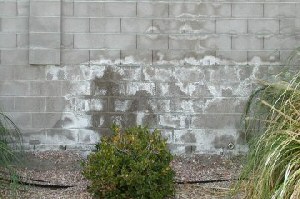What is Efflorescence
Efflorescence. What a weird word.
Efflorescence – ef-flo-res-cence (ef∋ le res∋ens), 1. a change on the surface to a powdery substance upon exposure to air, as a crystalline substance through loss of water. 2. to become encrusted or covered with crystals of salt or the like through evaporation or chemical change.
In English, efflorescence is that white, powdery stuff that you see on masonry walls. Because this isn’t a chemistry class, we are going to focus on prevention and remediation, instead of causation.
Although efflorescence is ugly and sounds scary, prevention and removal are simple and inexpensive.
How to prevent efflorescence
This is very easy. Make sure that the masonry substrate is at least 14 days old. If it seems uncured or “hot”, wait another week. Then, prime it using a masonry primers. Sherwin Williams makes a great product called Loxon Primer.
Once you have primed, simply apply an appropriate top coat and you are done. If you followed all of the manufacturer’s instruction, you should not have any problems with efflorescence.
How to remove efflorescence.
This is more difficult than prevention, but it isn’t a huge problem. First off, efflorescence is a cosmetic problem. It does not degrade the monolithic strength of the substrate. The efflorescence on the wall pictured above is ugly, but it won’t hurt the wall. So if you have efflorescence and it doesn’t bother you, leave it alone. If its unsightliness does bother you, here is how you fix it.
- Clean the efflorescence with muriatic acid. Be careful; hydrochloric acid is nasty stuff. You may need to dilute depending on the molar strength.
- Scrape the efflorescence.
- Make sure you have rinsed all of the muriatic acid and allow everything to dry thoroughly.
- Prime and repaint using the system described above in the “prevention” section.
I hope that you were entertained while reading this riveting expose` on efflorescence.
GreenWave is also the best interior house painters, exterior house painters, and house painting company and serves Atlanta, Alpharetta, Brookhaven, Buckhead, Chamblee, Doraville, Dunwoody, Grant Park, Inman Park, Johns Creek, Duluth, Milton, Roswell, and most major suburbs.



